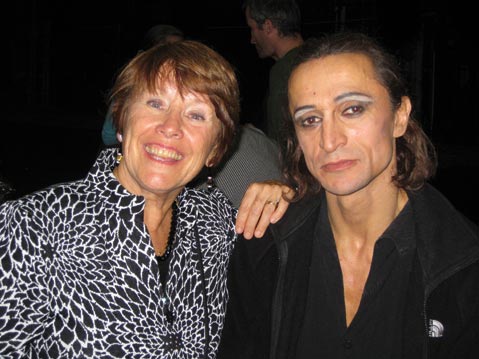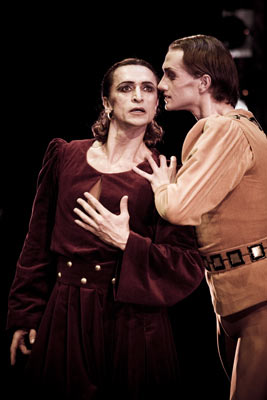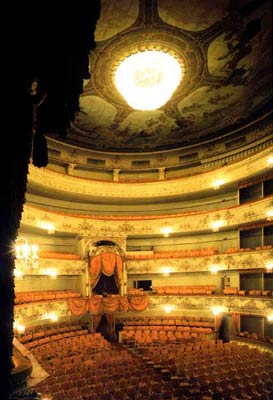S.B.’s Alice Condodina Brings Classic American Dance to Russia
The Moor's Pavane Travels from Santa Barbara to St. Petersburg

On a bitterly cold night this past November, Santa Barbara-based modern dance veteran Alice Condodina scurried past queues of Russian theatergoers in winter coats waiting to file into St. Petersburg’s Mikhailovsky Theatre. Condodina didn’t need to wait in line; she was a guest of honor. As part of the theater’s 175th Anniversary Season, the resident Mikhailovsky Ballet Company had invited Condodina to remount Jose Lim³n’s American modern dance masterwork, The Moor’s Pavane, on their Russian dancers. This was opening night.
Condodina, professor emerita of UCSB’s Department of Theater and Dance and 2003 recipient of Santa Barbara Dance Alliance’s Lifetime Achievement Award, was a principal dancer in the renowned Lim³n Dance Company in the 1960s and early ’70s, working directly with Jose Lim³n himself until the choreographer’s death in 1972. She also led her own dance company in New York City for a time, and founded UCSB’s Repertory West (now known as S.B. Dance Theatre) as artistic director, choreographer, and performer. She now travels the world as a master teacher setting works commissioned by the Lim³n Foundation as well as delivering her own lectures and workshops.

The 12 curtain calls and subsequent floral onslaught Condodina and her Russian cast received on opening night only added to the emotional charge of this event. The first performance of The Moor’s Pavane marked the culmination of an intensive, six-week residency, and also represented a historic milestone: a sort of artistic truce between the U.S. and Russia that had been years in the making.
In Communist-era Russia, modern dance was forbidden by law. More than almost any other Western cultural export, modern dance was seen as a direct expression of the American dream: unique, forward-thinking, and free from the buttoned-up, old-world rigidity of classical ballet. The modern techniques ushered in by Lim³n and his contemporaries in the early- to mid-20th century shunned tradition and aligned to create new training techniques and ultimately give the dance world a fresh new American voice.
Of course, Russia’s cultural freeze on Western influence had its perks; Russia became a storehouse for great restorations of famous 18th- and 19th-century ballets and its die-hard training regimens became codified and housed in the notorious Vaganova Academy, which spawned such greats as Anna Pavlova, Vaslav Nijinsky, Rudolf Nureyev, Natalia Makarova, and Mikhail Baryshnikov. But for years, the Russian people were denied access to the surge of artistic generation happening in the West.
When Condodina got the call asking her to bring Lim³n’s work to Russia, she understood immediately the significance of the offer. Her residency marks the first official licensing of Lim³n’s seminal work by a Russian ballet company. “The Russians were aware of Lim³n and have done pirated performances in the past,” she explained, “but this is the first time they’ve actually done the original version with the correct choreography, costumes, music, and lighting.”

The site of the performance, the Mikhailovsky Theatre, is located in majestic St. Petersburg’s famed Arts Square area, a stone’s throw from the Hermitage, the world’s largest museum. The theater originally was conceived by Tsar Nicholas I for his brother, the Grand Duke Mikhail Pavlovich. The first performance in the theater took place on November 8, 1833. In allowing Condodina’s production of the Russian premiere of The Moor’s Pavane to take place on the theater’s 175th anniversary, the Putin/Medvedev administration made a powerful statement about the place of American art in modern Russian culture. Incidentally, 2008 also marks Lim³n’s centennial year, were he alive today. The Moor’s Pavane, first performed in 1949 just three years after he started his dance company, is one of Lim³n’s seminal works, an ode to Shakespeare’s great tragedy of love, jealousy, and betrayal, Othello.
World-renowned Russian ballet superstar Farukh Ruzimatov performed the lead character, Othello, with surgical precision and stunning attention to detail. Ruzimatov currently is the Mikhailovsky Ballet’s artistic director, and previously was a principal dancer in the Kirov Ballet as well as a guest dancer for the American Ballet Theatre.
The company will include The Moor’s Pavane in its repertory for the next three years, running in St. Petersburg throughout December, then on international tour in early 2009. In January, Condodina will be reunited with Ruzimatov and his troupe for their performances of the work in Venice, Italy.
Modern-day Russia is a study of strange contrasts: the nouveau riche dodge their gleaming Lamborghinis through a maze of potholes in hopeless traffic, vodka is cheaper than water, laws are seemingly optional, and you’re more likely to be robbed by a police officer than a criminal. Post-Communist Russians are known for living in the moment and not taking joy for granted. They spend money as they make it, embrace freedom while it lasts, and feed their insatiable appetite for the arts. That a major Russian ballet company has taken so warmly to a modern American classic is evidence that cultural, if not political, barriers between the nations are eroding. Santa Barbarans should be proud that our city is playing a role in this cultural exchange.
4•1•1
For more on the Mikhailovsky Ballet Company or Farukh Ruzimatov, visit mikhailovsky.ru/en or ruzimatov.ru/eng.



